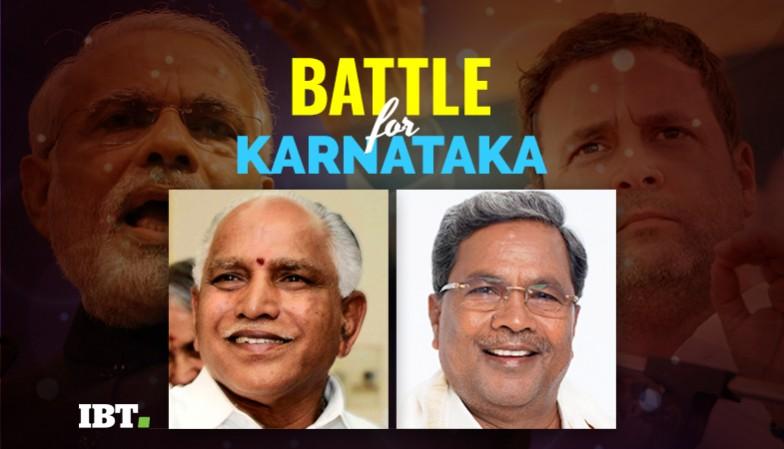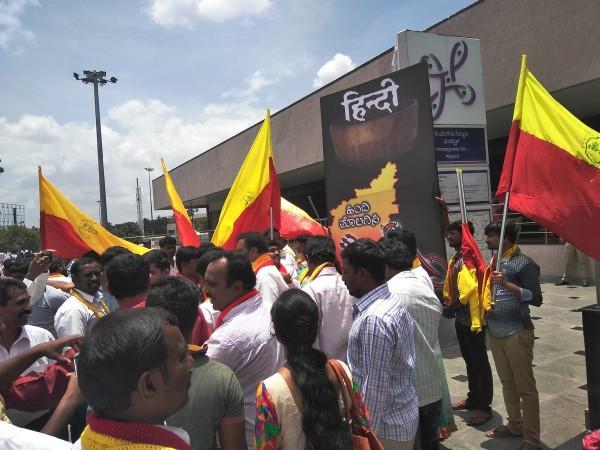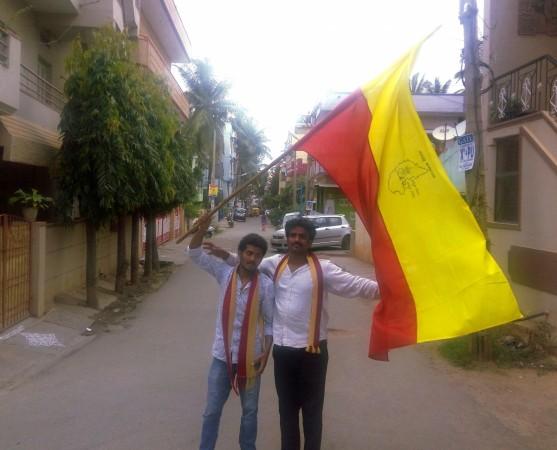
Karnataka election 2018 is moving into the top gear. Before the psephologists arrive on the scene to unravel its mysteries, here's a lexical effort to unlock the political battle. Key themes and terminologies that will be heard over the din of the campaign are thrown together here to help make sense out of the dervish dance of democracy. Here's the staple political diet for poll-bound Karnataka, explained:
1. Ahinda
Ahinda is a main campaign plank. The Congress uses as it a sold vote bank drummed up from a motely crowd of dalits, numerous backward classes and castes and the Muslims. For the Opposition BJP, it's a stick to beat Chief Minister Siddramaiah with. They allege the CM is anti-Hindu and is resorting to the ploy of dividing the religion.
-- Siddaramaiah has always been a champion of this demographic bloc, what with his socialist background et all.
-- How 'Ahinda' is pitted against BJP is amusing. As much as 84 percent of Kannadigas are Hindus while Muslims form only about 13 percent. However, Siddaramaiah has successfully carved up a vote bank from the backward communities and Muslims.
- BJP State President BS Yedyurappa called Siddaramaiah an 'Ahindu'. "Siddaramaiah led Congress govt has been the most anti-Hindu Govt in the history of Karnataka. CM himself has repeatedly boasted of his anti-Hindu image," he said.
-- Congress avers that 'Ahinda' and 'Ahindu' are different. It uses the Ahinda plank to burnish its secular credentials without shaking off a soft-hindutva line that will give electoral dividends. "I am also a Hindu but one with humanism ('manaviyate'). They are without humanism. I am a Hindu and was always one but I do not use religion in politics," Siddaramaiah says.
2. LIBRA
Libra denotes the secret success recipe for the BJP – the population bloc created by Lingayat plus Brahmins. Vast majority of this bloc traditionally vote for BJP. However, this year, Siddaramaiah has unleashed a caste offensive aimed at depleting BJP support from this bloc.
3. Lingayat
Karnataka Election 2018 revolves around the Lingayat community this time round. Lingayats comprise 15-17 percent of the population. As many as 50 MLAs in the current Assembly are from the community. Lingayats are a strong political force in North Karnataka, Hyderabad-Karnataka (north-east Karnataka) and Old Mumbai region (Bombay-Karnataka).
The blessings of Lingayat seer Shivakumara Swami, who is 111 years old, are publicly sought by all political parties. He is known as walking god and is thought to be the incarnation of great seer Basava. He heads the Siddaganga mutt in Tumakuru and hundreds of institutions under it. Amit Shah, Rahul Gandhi and Siddaramaiah paid visits recently.
4. Akhila Bharata Veerashaiva Mahasabha
The Akhila Bharata Veerashaiva Mahasabha (ABVM) opposes the Siddaramaiah government's decision to give 'religious minority' status for 'Lingayat and Veerashaiva-Lingayats'. The new stand is in sharp contrast to the Sabha's earlier view on the hot topic.
-- Shivayoga temple in Badami is the nerve centre for Veerashaiva seers who oppose the decision to give special religion status to Lingayats. Former Congress minister Shamanur Shivashankarappa is the Mahasabha president. His son is currently a minister in the Siddaramaiah cabinet.
-- Jaagrathika Lingayat Mahasabhe is the splinter organization that was formed after the Lingayat faction in the Akhila Bharatha Veerashaiva Mahasabha moved away over differences over the minority religion status for the Lingayats. While the Lingayat camp in the original Mahasabha want special religion status, the Veerashaivas oppose this. The Veerashaivas believe both schools of thought are the same. However, the Lingayats disagree.
"In the 1870 we were a separate religion. We were not part of Hinduism. This doesn't mean we are anti-Hindu. It's a historical truth that we were a separate religion. We were added to Hinduism later," minister MB Patil, a Lingayat faction leader, has said.
5. Basava Tatwa (Basava philosophy)
Basavanna or Lord Basava of the 12th century built his philosophy around the notion of egalitarianism. If everything originates from a single source, discrimination cannot exist, according to him.
Basava taught the world "the importance of Enlightenment, Work Culture, Democracy, Human Rights, Gender and Racial equality to form an egalitarian Society,: according to Lingayat Religion.
Siddaramaiah government used the Lingayat religion issue to the hilt in the run-up to the election. One populist move was the order to display Basavanna's photo in all government offices.
6. Vokkaliga
The Vokkaligas forms 12 percent of the population. There are 53 MLAs from the community in the current assembly. The Vokkaligas, like the Lingayats, belong to the Other Backward Communities category. However, they are, again like the Lingayats, seen as the forward segment among the backward communities.
In 2008, 42 percent of Vokkaligas voted for JD(S) while 38 per4cent voted for Congress. BJP got the support of only 19 percent of the Vokkaligas. However, the fortunes of the party changed in the 2014 Lok Sabha election, in which it got 38 percent of votes from the Vokkaliga community as per the CSDS survey.
7. Kurubas and Valmikis
The Kurubas are a backward community and they are also in the OBC bloc. In Karnataka the Kurubas are also known by different names like Kadu Kuruba, Jen Kuruba and Gonda. The Haalumatha Mahasabha, the umbrella organisation representing the community, says there are around 50 lakh Kurubas in the state. They have been demanding the Scheduled Tribe (ST) status. Chief Minister Siddaramaiah, a Kuruba, had pitched for raising the reservation limit in the state, looking to keep the Kuruba leaders' hopes alive.
-- Valmiki Nayak community has significant presence in North Karnataka. Traditionally the community votes for either the Congress or the BJP. This time, JD-S strategists have managed to pull off an early coup by arranging a meeting between actor Sudeep, who hails from the community, with HD Kumaraswamy. Time will decide if this can swing any votes in favor of Janata Dal (S).
8. Karnataka Caste Census
According to government figures, there are around 1,360 caste groups in Karnataka. However, an attempt by the Congress government to conduct a census became controversial. The Karnataka Backward Classes Commission conducted a caste survey in the state. Unofficial figures reported by TV channels put the scheduled castes and the scheduled tribes as the biggest caste bloc in the state at 25 percent of the population. According to the survey, SC accounted for 18 percent and the ST 7 percent.
The caste survey's expenses amounted to Rs 147 crore. It covered 13.5 million households in 45 days. One of the surprises of the survey was the lower numbers of the two prominent communities - Lingayats and Vokkaligas, prompting the government to deny the authenticity of the leaked numbers.
9. 70% Reservation
Eying re-election, Siddaramaiah has beefed up his Ahinda support base with a variety of actions and promises, including a 70 percent reservation for SC/ST and OBCs in education and public sector services. The Kuruba demand for being added in the Scheduled Tribe category will also resound in the election season.
10. Pro-Kannada and anti-Hindi
Hindi sign boards across metro stations in Bengaluru kicked off controversy and then a popular protest in the state in 2017. This was somewhat of a novelty in the state whereas in neighboring Tamil Nadu, where anti-Hindi sentiment is the basic premise of the political identity. Perhaps, with a view on the upcoming elections, the government openly supported the anti-Hindi sentiment. The movement was easily interpreted as the expression of a more simplistic pro-Kannada sentiment. Workers of the Karnataka Rakshana Vedike, who blackened Hindi signboards, led the protest.

11. Mutts, Peethas and Seers
The ashrams, mutts and peethas are much frequented places by political leaders during the entire course of the election campaign. National leaders of Congress and BJP take pains to be at all mutts and peethas and pay homage to all seers.
That apart, one of the popular seers in Udupi has already joined the election battle. Lakshmivara Theertha Swamiji of Shiroor Mutt is reportedly eying a BJP ticket. He belongs to one of the Ashta Peetha's – the eight mutts -- in the district.
Basavananda Swamiji from Dharward and Chennaiah Swamiji of the Madara Chennaiah Mutt in Chitradurga are others who have made open political ambitions.
12. Cash, liquor and gold
Note for vote is a reality despite claims otherwise. Reels of newsprint will be spent on the money trail in this election. Even before the election notification has arrived, the Election Commission has seized as much as Rs 1,21,47,570 in cash, 139 litres of liquor and 2.46 kg of gold. That's in addition to the 2,675 litres of liquor seized by the Excise Department and many other smaller cash hauls.
13. Dynastic politics
Dynastic politics is equally loved and loathed in Karnataka. Loved when it's your kin who get the ticket and loathed when it makes its ugly head in the opposition camp. Congress state president has gone on record saying the party leadership has already received as many as 25 applications from sons and daughters of top level Congress leaders. On the other side, at least half a dozen candidates can be expected from HD Deve Gowda's family, including children, gran children and their spouses. BJP too isn't untainted either, as the son of BS Yedyurappa is the likely candidate in the Varuna constituency in Mysore region.
14. Swaraj India
Yogendra Yadav's fledgling party is making an entry into Karnataka politics with this Assembly election. It will contest in a handful of seats and has already announced candidates to select seats in Mysuru-Bengaluru belt
15. Yakshagana
Yakshagana, the colorful dance drama Karnataka has gifted to the art world, has become an unwitting victim of electoral politics this time. There's a clampdown on Yakshagana presentations this time around, with government observers keeping the performances under watch to trace out any political theme in them. The art form steeped in mythical traditions is widely celebrated in coastal Karnataka, with artistes in hundreds of troupes making a livelihood during the November-May season.
16. Karnataka flag
The Karnataka flag gives a separate symbolic identity for the state. In March this year, the state cabinet unveiled the Karnataka flag, in good time before the election processes began. It's a tricolour flag of yellow, white and red and sports the 'ganda bherunda' in the middle. Scholars and pro-Kannada activists were on the committee that designed the flag. Yellow symbolizes forgiveness, white means peace and red marks bravery. The flag must be approved by the Union Ministry of Home Affairs. The flag will be a vote plank as Congress can easily corner BJP over the 'local sentiment'

17. Mahadayi river dispute
The river dispute originated in the 1980s when Goa objected to Karnataka's plan to build dams in the river. Goa said its people depend on the river waters and its natural course should be preserved. There's also dispute over the amount of water from Mahadayi, known as Mandovi in Goa, to be shared between the two states. The river comes alive in the Bhimgad Wildlife Sanctuary in Belagavi district and flows into Goa before joining the Arabian Sea in Panaji. There will be claims and counter-claims over whose policies have benefitted the state most.
18. Bhagya Schemes
The various bhagya schemes or welfare programs are a main poll plank for the Siddaramaiah government. These schemes mainly cater to the rural poor and address issues from malnutrition to income generation. The main bhagyas started by the governments are arogya (health) bhagya, anna (rice) bhagya, anila (gas) bhagya, shoe bhagya, pashu (cattle) bhagya and ksheera (milk) bhagya. The opposition always hits back saying these are the re-incarnation of welfare schemes started by their governments.
19. Indira canteen and Appaji canteen
Chief Minister Siddaramaiah scored big among the poorer sections of the population with the launch of the Indira canteens, which offered full meals at rock bottom prices. Even as the plan was on the anvil, the JD-S hit back by launching a canteen chain of its own -- the Appaji canteens named after former Prime Minister HD Deve Gowda. Both these canteens offer full breakfast at Rs 5 and lunch atr Rs 10. Tea and coffee are sold at Rs 3.
20. Namma TYGR Taxi
Namma TYGR cabs was announced by JD (S) supremo HD Kumaraswamy as Bengaluru's answer to Uber and Ola. The local web taxi service was launched with the tall claim that it will address two issues at the competing ends == protect drivers from the 'exploitation' by established players and protect the customers from surge pricing. The ambitious project was thought to give HDK and his party great mileage in the upcoming election. However, it hasn't logged many miles after seeing a damp-squib start. The taxis were pulled off the roads as the company hadn't obtained the necessary transport license.
21. Tipu Jayanti
Tipu Jayanti is another instance of history playing truant with present-day politics. The whole issue revolves around the question if erstwhile Mysore ruler Tipu Sultan was a patriot or not. Whether he was a symbol of communal harmony or someone who destroyed it. The question is whether he protected Hindu temples or demolished them.
Congress calls him an icon of communal harmony, pointing out that he protected the famous Sringeri Mutt from a Maratha attack. The BJP says he is linked to temple demolitions and oppression of Hindus. The Congress government in Karnataka has been celebrating Tipu Sultan Jayanti since 2014 amid protests by the Sangh Parivar outfits.

22. Bombay-Karnataka region
Seven districts of north-western Karnataka including Hubli-Dharward, which were formerly under the Bombay Presidency, are in the region. There are 56 assembly seats in the region. Congress and the BJP are in a direct fight in the belt. In 2013 elections, Congress won 34 seats and BJP 14. JD-S could win in only one seat.
23. Hyderabad-Karnataka region
Northern districts of Karnataka (Bijapur, Raichur, Gulbarga, etc.) that once formed part of the Nizam's empire form this belt. This region comprise the districts neighbouring Andhra Pradesh. In 2013, Congress romped home in the majority of seats here. It won 19 seats while BJP and JD-S won in four each.
24. Old Mysore region
The Old Mysore section, as the name suggests, comprises the regions which were formerly under the rule of the Mysore royals in the south. It's a Congress and Vokkaliga stronghold. Congress won 40 seats in 2013 while the JD-S got 30 seats.
25. Coastal Karnataka
The communally sensitive region is a BJP stronghold. The Dakshina Kannada and Udupi districts have been on the boil for long, with RSS, Bajrang Dal and VHP locking horns with militant minority organizations.

















